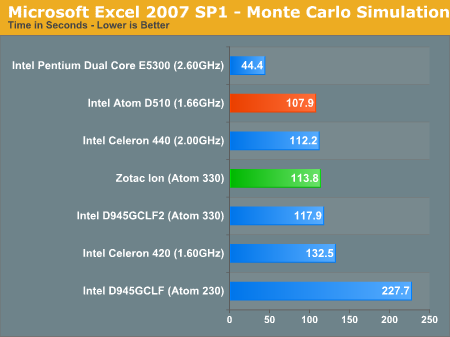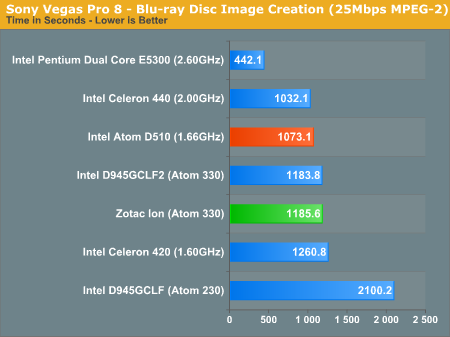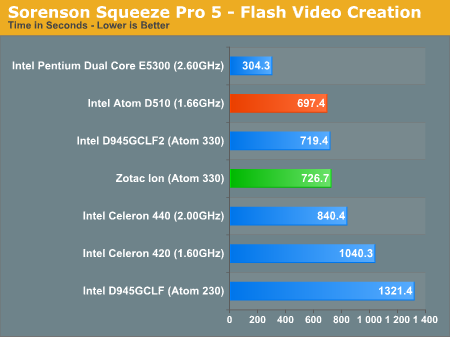Intel Atom D510: Pine Trail Boosts Performance, Cuts Power
by Anand Lal Shimpi on December 21, 2009 12:01 AM EST- Posted in
- CPUs
PAR2 Multithreaded Archive Recovery Performance
Par2 is an application used for reconstructing downloaded archives. It can generate parity data from a given archive and later use it to recover the archive
Chuchusoft took the source code of par2cmdline 0.4 and parallelized it using Intel’s Threading Building Blocks 2.1. The result is a version of par2cmdline that can spawn multiple threads to repair par2 archives. For this test we took a 708MB archive, corrupted nearly 60MB of it, and used the multithreaded par2cmdline to recover it. The scores reported are the repair and recover time in seconds.

WinRAR - Archive Creation
Our WinRAR test simply takes 300MB of files and compresses them into a single RAR archive using the application's default settings. We're not doing anything exotic here, just looking at the impact of CPU performance on creating an archive:

Again we see almost a 10% increase in performance thanks to Pine Trail, even when compared to NVIDIA's Ion platform.
Microsoft Excel 2007
Excel can be a very powerful mathematical tool. In this benchmark we're running a Monte Carlo simulation on a very large spreadsheet of stock pricing data.

Sony Vegas Pro 8: Blu-ray Disc Creation
Although technically a test simulating the creation of a Blu-ray disc, the majority of the time in our Sony Vegas Pro benchmark is spend encoding the 25Mbps MPEG-2 video stream and not actually creating the Blu-ray disc itself.

Sorenson Squeeze: FLV Creation
Another video related benchmark, we're using Sorenson Squeeze to convert regular videos into Flash videos for use on websites.











41 Comments
View All Comments
Jeffk464 - Monday, December 21, 2009 - link
This might be a decent solution with the broadcom media chip making it capable of playing HD content and hopefully flash media.dealcorn - Monday, December 21, 2009 - link
If I am reading correctly the Intel platform with Broadcom media accelerator (about $25) is cheaper than the Ion platform and will consume less energy. Some relevant perfortmance testing may help determine whether the Intel platform is positioned to dominate the frugal HTPC market.It is a bummer that you will need to spend chump change for a SATA port card to enable software raid 5 for a frugal media server.
Likely, the incremental performance improvements are adequate for Intel to maintain its cachet in the dissed, real world netbook market with its surprisingly large volumes.
Its kinda a nothing platform, but in context may be a home run.
Jeffk464 - Monday, December 21, 2009 - link
For it to be a solution for me it needs to be on a mobo that has a pcie slot and hdmi through the broadcom chip. I'm not to hopeful though, will probably end up with a i3 solution. Too bad, I like the idea of going super low wattage.psychobriggsy - Monday, December 21, 2009 - link
The platform is standing still apart from getting more integrated. Hopefully that will mean cheaper. Maybe some netbooks will get cheaper, but otherwise the platform is a complete waste of time because of the lack of HD video capability (for Intel to call the graphics "HD Graphics" is verging on consumer misrepresentation, it can't even do 1080p output via HDMI/DVI, what is this, 2005?).Why did the review concentrate on benchmarks of applications nobody would run on such a system?
These chips are a solution for nothing apart from the unwealthy Office user who needs 8 hours of battery instead of 6.
Jeffk464 - Monday, December 21, 2009 - link
It can be used for a low power/cost network storage device.Zool - Monday, December 21, 2009 - link
There could be a test with underclocked and undervolted E5300 against the Atom D510. Maybe Power vs performance would be quite close if not better for the E5300. I think that everyone could take another 10W for a performance thats not crapy (even netbooks).Calin - Monday, December 21, 2009 - link
10 more watts would mean going from 8-9 hours of socket-free operation down to 6 (or maybe less). Not acceptable for the people that want 8 hours of socket-free operation. As for higher performance CPU, you have the low voltage processors (CULV), which will better fit the bill.Zool - Monday, December 21, 2009 - link
Thing is that 10+ more wats in CPU doesnt mean that u use it all the time. For internet browsing and so (not like u can use it efectivly for something more) the cpu isnt working 100% all the time just sporadicly.Majority of the power usage in those scenarios is in the rest of the hardware like display ,gpu, mainboard which runs all the time.
And i dont even say that with faster cpu the task are faster done so u use the cpu on 100% state less time in total.
Atom is the only one of its kind now and without competition it will stay this crapy for long time.
cjs150 - Monday, December 21, 2009 - link
There are 3 markets for this type of product: notebooks, HTPC and cheap file servers:HTPC market: complete failure because the graphics are not up to scratch
Cheap file server: only SATA ports but I could add my raid card to this but the given the cost it would be cheaper to buy a NAS box
Notebooks: barely adequate - word processing and simple internet browsing only.
So for 2 out of 3 markets it is a waste of space and the 3rd market it is merely sub-par what is already out there
Jeffk464 - Monday, December 21, 2009 - link
Don't give up yet, mobo manufacturers have the option to put a broadcom media chip on their boards. I don't know if this will come with HDMI though. Have to wait and see.